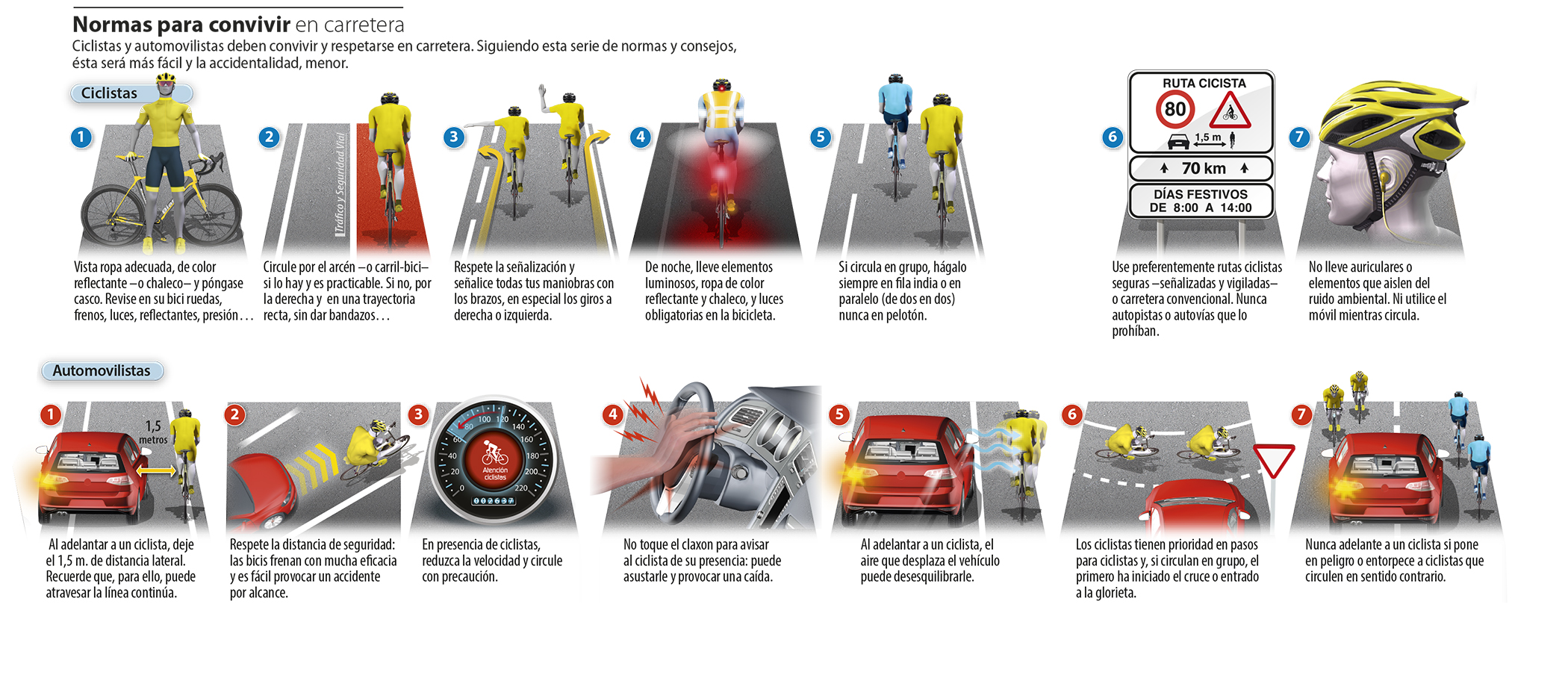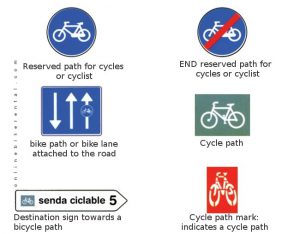
Cycling laws in Spain.
EXERCISE: The use of the bicycle supposes the realization of cardio healthy physical exercise, which protects against numerous illnesses.
ECONOMY: The bicycle is the most economical means of transport, both in terms of acquisition and maintenance, and does not require fuel.
SPEED: It is faster than the car, in short and medium distances, in the city.
ARKING: Easy to park.
NO CONTAMINATION: It is a means of transport that does not contaminate with toxic gases or noise.
SPORT: Easy to practice either individually or in a group.
POSITION: It is important that the size of the bicycle is adequate for the height of the rider, and that the position is correct: the rider, placed on the frame, will be able to put his feet on the ground. The saddle and the handlebar must be at the same height.
LIGHTING: If you are driving at night, underpasses and tunnels, it is necessary to have the corresponding lighting. The lighting system of the bicycle must have: - In the front a white position light. - In the rear a red position light and a non-triangular reflector, of the same color. Optionally, auto yellow reflectors can be added, on the spokes of the wheels and two on each pedal.When it is mandatory to use the lighting, cyclists will also wear a reflective garment if they are driving on interurban roads, in order to that drivers and other users can distinguish them at a distance of 150 meters.
HELMET: MOBILES AND RECEIVERS: The homologated safety helmet is compulsory for drivers and occupants of bicycles, if they travel on interurban roads, except on long ascending ramps, for accredited medical reasons or in extreme conditions of hot.
Driving and using headphones connected to sound receivers or players and the use of mobile phones are prohibited.
PASSENGERS: On bicycles, for one person, only one passenger is allowed, in an additional approved seat, if the passenger is under seven years of age and the driver is of legal age.
BEFORE JOINING THE CIRCULATION AND STARTING THE RIDE: It is necessary to check, looking back, that other vehicles are not approaching or that they are far enough away. It is also mandatory to signal the maneuver to the rest of the users of the track, extending the arm horizontally at shoulder height.
If there is little visibility or the traffic is complicated, for safety reasons, there will be circulated in a row, one by one. The bicycle has priority of passage, with respect to motor vehicles, when driving: on a bicycle lane, on a passage for cyclists, or on a properly road shoulder duly marked.
THE PASSAGE MUST BE GIVEN: In front of a duly signposted pedestrian crossing or when you are about to turn, to enter another road and there are pedestrians crossing it, even if there is no crossing for these. step will be verified, always, according to the signaling that regulates it: Either an agent with the arm raised vertically or with the arm or arms extended.
Also in front of a light signal such as the red light of the traffic light or the non-flashing yellow light, unless the cyclist is so close to the stopping place that he cannot stop safely before the traffic light, and always before a horizontal signal. Mandatory Stop or Stop.
TO STOP OR IF YOU NEED TO BRAKE BRUSCALLY: This should be indicated by moving the arm, alternately up and down, with short and quick movements.
TURN TO THE RIGHT: Position yourself as close as possible to the right edge of the roadway and check if the situation of the other road users allows the turn, warning the maneuver with enough time with the left arm bent upwards and with the palm extended, or with the right arm in a horizontal position and with the palm of the hand extended downwards.
TURN TO THE LEFT: go as far as possible to the left edge of the road and signal the maneuver long enough, extending the left arm horizontally at shoulder height and with the open hand downwards or with the right arm bent upwards and the palm of the hand extended. IF THE ROAD IS DOUBLE DIRECTION, it is necessary to stick to the longitudinal or median mark of separation and if it does not exist on the axis of the road, without invading the area destined for the opposite direction. Whether urban or interurban, you have to be in it, well in advance, and turn when the existing signs allow it.
IF THE ROAD IS SINGLE SENSE IF THE ROAD HAS A CONDITIONING LANE-DO FOR THIS TURN,
IF THE INTERURBAN ROAD DOES NOT HAVE A CONDITIONED LANE, for the left turn, you must position yourself to the right, out of the road whenever possible, and start it from that place.
IF THERE IS NO ROAD FOR CYCLISTS,
In the event that there is no road, or part of it that is especially intended for cyclists, you must drive on the shoulder on the right if it is passable or sufficient, and if it is not, the essential part of the roadway.
You can only leave the shoulder on prolonged descents with a curve, when safety reasons allow it, except when driving on a motorway.
PASSING A VEHICLE OR OBSTALCES,
It is necessary to warn it in advance, and check that there is enough space so that the maneuver does not endanger or hinder those who circulate in the opposite direction. The lateral distance with the vehicle being overtaken shall not be less than 1.5m.
It is not considered overtaking that produced between cyclists who circulate in a group.

Oficial DGT page: http://www.dgt.es/PEVI/eduvial/guias-didacticas-recursos/Guia-del-ciclista-marcadores.pdf
- EJERCICIO:El uso de la bicicleta supone la realiza-ción de ejercicio físico cardiosaludable, que protege ante numerosas enferme-dades.
- ECONOMIA:La bicicleta es el medio de trans-porte más económico, tanto por lo que se refiere a su adquisición como a su mantenimiento, y no necesita combustible.
- RAPIDEZ:Es más rápida que el coche, en distancias cortas y medias, en la ciudad.
APARCAMIENTO:Se aparca fácilmente.
NO CONTAMINA:Es un medio de transporte que no contamina con gases tóxicos o ruidos.
DEPORTE:Fácil de practicar ya sea individual o en grupo.
POSICION:Es importante que el tamaño de la bicicleta sea el adecuado para la al-tura del ciclista, y que la posición sea la correcta: el ciclista, situado sobre el cuadro, podrá apoyar los pies en el suelo. El sillín y el mani-llar deben estar a la misma altura.ALUMBRADO:Si se circula por la noche, pasos inferiores y túneles es necesario llevar el alumbrado que corresponda.El sistema de alumbrado de la bicicleta deberá llevar obligatoriamente:- En la parte delantera una luz de posición de color blanco.- En la parte trasera una luz de posición de color rojo y un ca-tadióptrico, no triangular, del mismo color. Opcionalmente se pueden añadir catadióptricos de color amarillo auto, en los radios de las ruedas y dos en cada pedal.Cuando sea obligatorio el uso del alumbrado los ciclistas llevarán, ade-más, una prenda reflectante si circulan por vías interurbanas, con el fin de que los conductores y demás usuarios puedan distinguirlos a una dis-tancia de 150 metros.
6CASCO:MÓVILES Y RECEPTORES:El casco de protección, homolo-gado, es obligatorio para conduc-tores y ocupantes, de bicicletas, si circulan por vías interurbanas, salvo en rampas ascendentes pro-longadas, por razones médicas acreditadas o en condiciones ex-tremas de calor.Está prohibido conducir y utilizar auriculares conectados a receptores o reproductores de sonido así como el uso del teléfono móvil.PASAJEROS:En bicicletas, para una persona, sólo se permite llevar un pasajero, en asiento adicional homologado, si este es menor de siete años y el conductor mayor de edad.La tasa máxima de alcoholemia, de los conductores en general (0.5 g/l de alcohol en sangre o de alcohol en aire espirado superior a 0.25 miligramos por litro) también afecta a los ciclistas que están obligados, como otros con-ductores, a someterse al preceptivo test de alcoholemia
ANTES DE INCORPORARSE A LA CIRCULACIÓN E INI-CIAR LA MARCHA:Hay que comprobar, mirando ha-cia atrás, que no se acercan otros vehículos o bien que están sufi-cientemente lejos.Es obligatorio, también, señalizar la maniobra al resto de los usuarios de la vía, extendiendo el brazo horizontalmente a la altura del hombro.
CUANDO SE CIRCULA POR LA CIUDAD:Hay que hacerlo lo más próximo posible a la de-recha de la vía.Si se va en grupo se podrá circular en columna de a dos, como máximo.
Si hay poca visi-bilidad o el tráfi-co se complica, por seguridad, se circulará en hilera, de uno en uno.Se tiene prioridad de paso, respecto a los vehículos de motor, cuando se circule: por un carril bici, por un paso para ciclistas, o por arcén debidamente señalizado.
También se tiene prioridad de paso cuando el vehículo de motor vaya a girar, a la derecha o a la izquierda, para entrar en otra vía y el ci-clista esté próximo o cuando circulando en grupo el primero haya iniciado el cruce o haya entrado en una glorieta.
SE DEBE CEDER EL PASO:Ante un paso para peatones debidamente señalizado o cuando se vaya a girar, para entrar en otra vía y haya pea-tones cruzándola, aunque no haya paso para estos.AL APROXIMARSE A UNA INTERSECCIÓN O CRUCE:La preferencia de paso se verificará, siempre, atendiendo a la señali-zación que la regule: Ya sea un agente con el brazo levantado verticalmente o con el brazo o brazos extendidos.
También ante una señal luminosa como la luz de roja del semáforo o la luz amarilla no intermitente, salvo que el ciclista se encuentre tan cerca del lugar de detención que no pueda parar, antes del semáforo, de forma segura.Y siempre ante una señal horizontal de detención obligatoria o Stop.
PARA PARAR O ANTE LA NECESIDAD DE FRENAR BRÚSCAMENTE:Hay que indicarlo moviendo el brazo, alternativamente de arriba abajo, con movimientos cortos y rápidos.
GIRO A LA DERECHA:Hay que situarse lo más cerca posible del borde derecho de la calzada y comprobar si la situación de los demás usuarios de la vía permite realizar el giro, advirtiendo la maniobra con tiempo suficiente con el brazo izquierdo doblado hacia arriba y con la palma extendida, o bien, con el brazo derecho en posición horizontal y con la palma de la mano extendida hacia abajo.
15GIRO A LA IZQUIERDA:hay que situarse, lo más cera posi-ble, al borde izquierdo de la calzada y señalizar con suficiente tiempo la maniobra, extendiendo horizontal-mente el brazo izquierdo a la altura del hombro y con la mano abierta hacia abajo o con el brazo derecho doblado hacia arriba y la palma de la mano extendida. SI LA VÍA ES DE DOBLE SENTIDO hay que ceñirse a la marca longitu-dinal de separación o mediana y si ésta no existiese al eje de la calza-da, sin invadir la zona destinada al sentido contrario. ya sea urbana o interurbana, hay que situarse en él, con suficiente antelación, y girar cuando la se-ñalización existente lo permita. SI LA VÍA ES DE SENTIDO ÚNICOSI LA VÍA TIENE UN CARRIL ACONDICIONA-DO PARA ESTE GIRO,
http://www.dgt.es/PEVI/eduvial/guias-didacticas-recursos/Guia-del-ciclista-marcadores.pdf



